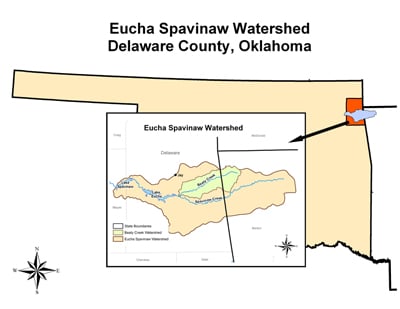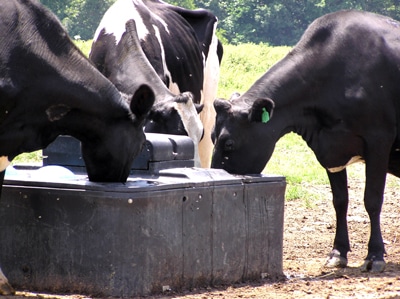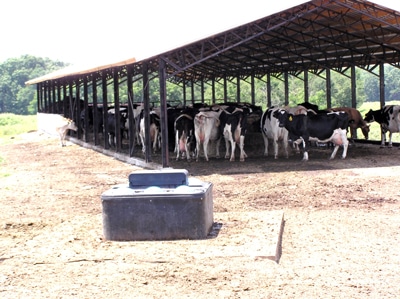Successful Eucha/Spavinaw Water Quality Improvement Projects Extended

Jay, OK – Located in far northeast Oklahoma, Spavinaw Creek is an important tributary to Lake Eucha, and eventually, Lake Spavinaw. These sister lakes provide water to citizens in Tulsa, Jay, and Spavinaw with total service nearing half a million people. Lakes Eucha and Spavinaw have been on the U.S. Environmental Protection Agency’s (EPA) list of impaired waters since at least 2002 due to high nutrient levels (primarily phosphorus) and low dissolved oxygen. Both reservoirs are considered to be eutrophic, experiencing excessive algae growth in response to the high nutrients, particularly phosphorus. These algal blooms have resulted in significant taste and odor problems and have led to considerable water treatment costs for the City of Tulsa.
To improve the water quality of Lakes Eucha and Spavinaw and their supplying streams, the Oklahoma Conservation Commission (OCC) and the Delaware County Conservation District initiated a series of watershed projects beginning in 1998 to address the significant sources of pollution. Funded by the EPA’s 319 Nonpoint Source Program, the Oklahoma legislature, and local landowners, these projects work to implement “Best Management Practices” (BMPs) in order to reduce nonpoint source (NPS) pollution. Nonpoint sources are those which supply pollutants to surface waters diffusely, rather than delivery from a single location such as a pipe outfall. These sources typically involve land management activities that contribute bacteria, sediment, and nutrients to surface water as a result of runoff during and following rainfall events.

Through these projects, BMPs are installed on a voluntary, cost-share basis with approximately 60 percent of the cost being paid by EPA funds and the remainder funded by the state and participating landowners. The process of planning and implementing these practices involves one-on-one meetings with landowners to evaluate current practices and educate them about things they can do to improve land production while conserving natural resources on their land. Approximately 200 landowners in Delaware County have participated in these projects to date, resulting in a total of $3,524,606 spent under the Spavinaw Creek Projects.
BMPs for the project were selected by the local stakeholders in the watershed functioning through a Watershed Advisory Group (WAG). Established by the local conservation district, the WAG comprises representatives from principle stakeholder groups including cattlemen, poultry growers, dairymen, representatives of the City of Tulsa, and conservation district board members. Upon selection of BMPs most appropriate to address the water quality challenges, the WAG then determines the cost-share rates for each BMP based on conservation priority. Practices known to be most effective at reducing pollution or more difficult for the landowner to maintain receive a higher cost-share rate than those which are widely implemented but less effective for water quality improvement goals.

Water quality monitoring associated with the Beaty Creek Project demonstrated that a similar implementation effort reduced phosphorus loading to Lake Eucha by at least 31 percent overloading rates without BMPs. This water quality success, combined with overwhelming local support from landowners, the Delaware County Conservation District, and USDA Natural Resource Conservation Service (NRCS) staff has resulted in a recent approval of a two-year extension for the program to spend an additional $1.5 million in BMP installation. In total, the two programs will spend at least $5 million dollars to improve water quality and wildlife habitat in the Eucha/Spavinaw watershed.
Joe Schneider, OCC watershed coordinator supervisor, explained that the success of water quality projects such as these in Spavinaw and Beaty Creeks is only possible because landowners have willingly invested time and money to install BMPs. Through this voluntary, cost share approach, landowners are able to make improvements to their operation and land that also benefit water quality in the area. To date, participants have contributed over $1.2 million of their own funds plus countless hours of time toward practices which improve the area along streams (termed the riparian zone), improve and maintain healthy pastures, stabilize streambanks, dispose of animal and human wastes properly, and facilitate effective fertilizer application.
In addition to these 319 Projects, OCC, conservation districts, the City of Tulsa, Oklahoma Scenic Rivers Commission, USDA Farm Services Agency, NRCS, and EPA are partners in a follow-up program to implement additional management efforts in the watershed. This program, the Conservation Reserve Enhancement Program (CREP), will devote at least $20.6 million dollars towards the long-term protection of riparian areas in the Eucha/Spavinaw and Illinois River Watersheds. As part of the overall CREP, the City of Tulsa has partnered with the Land Legacy to devote at least $1.25 million towards the permanent protection of riparian areas in the watershed.
Complementary to the intensive implementation work, Eucha/Spavinaw watershed project staff have provided numerous educational events and workshops to producers and local citizens in the area. Since 2006, over 300 people have toured the Spavinaw Creek Demonstration Farm near Jay, which showcases many different BMPs on a single farm. Project staff have implemented self-guided tours for individuals interested in viewing the BMPs established on the farm. For more information about these tours or the Spavinaw Watershed Projects in general, please contact Joe Schneider or Marti Mefford at (918) 253-8550.
